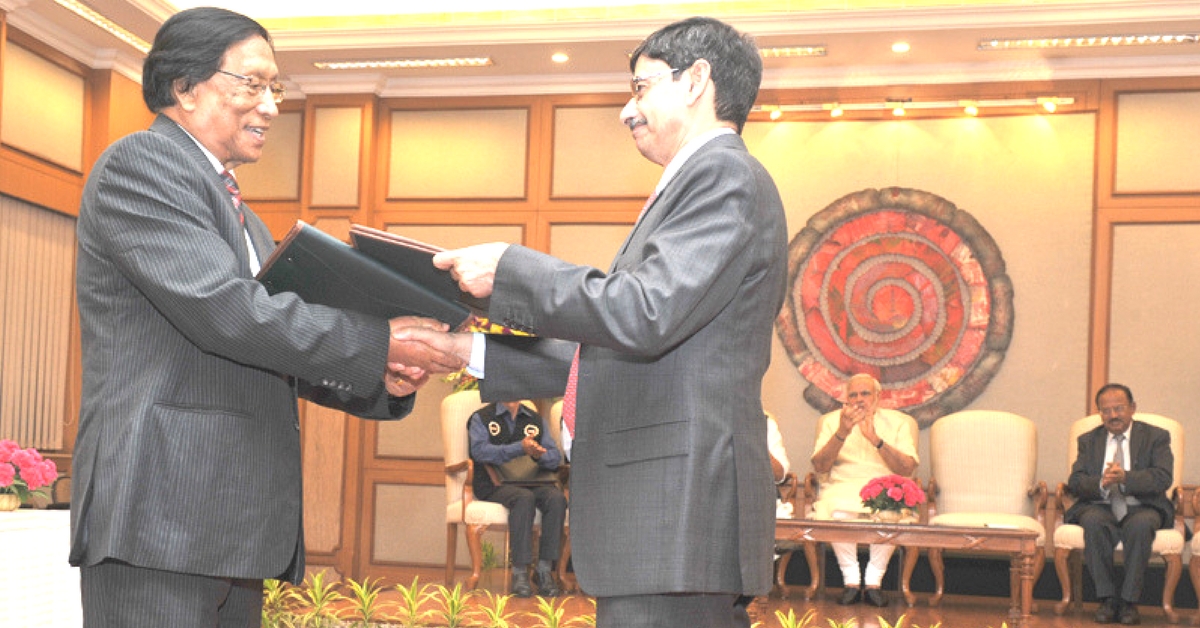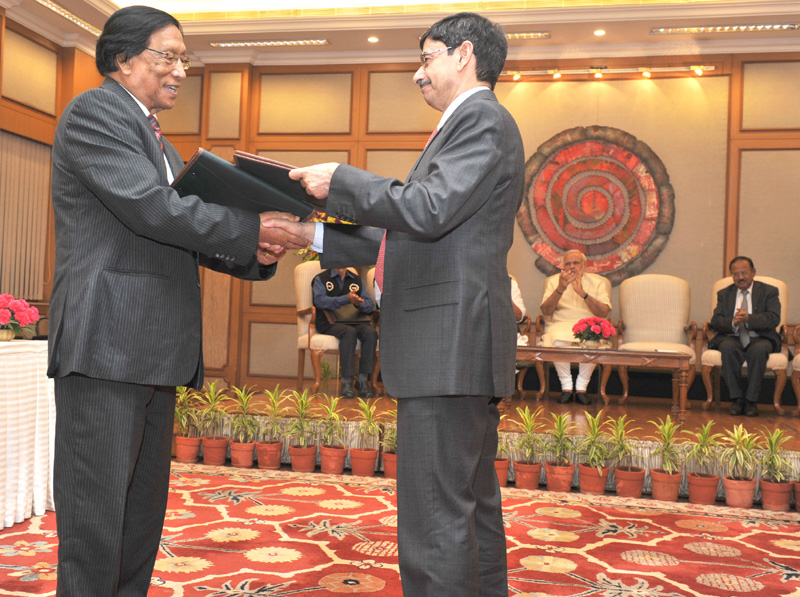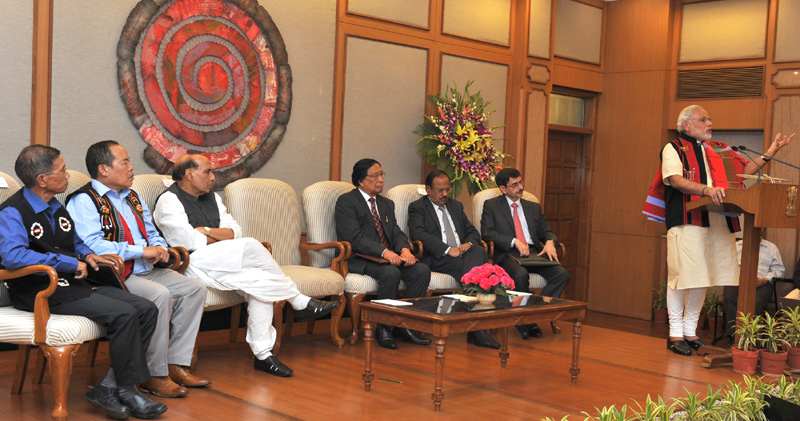How to End India’s Oldest Insurgency? This Former Cop Has Some Answers
With the final Naga peace agreement on the horizon, one must look back at the man behind the deal.

When the Centre, the Naga insurgent groups led by the National Socialist Council of Nagalim (Isak-Muivah), and local civil society organisations signed the Naga Peace Accord in August 2015, there was hope that it would mark the end of India’s oldest separatist movement.
Under this agreement, the Government of India recognised the unique history, culture, and position of the Nagas, their sentiments and aspirations, while the NSCN (I-M) accepted the legitimacy of the Indian political system.
Although the public is not privy to the fine details of this agreement, there are reports that the NSCN (I-M) will seek greater autonomy for Naga-inhabited areas both within the state and “all contiguous Naga-inhabited areas,” in the adjoining states of Assam, Arunachal Pradesh, and Manipur.

This assertion of Naga nationalism predates Independence and traces its history to colonial rule when the British gained administrative control of the Naga Hills in 1881. With the formation of the Naga Club in 1918, the Nagas publicly asked the Simon Commission for complete sovereignty and a return to the status quo before the British took control of the hills.
In 1946, the Naga National Council was formed, and it declared Nagaland as an independent entity under their charismatic leader Angami Zapu Phizo. Six years later, the underground Naga Federal Government and Naga Federal Army were born. New Delhi saw this development as a threat and enacted the draconian Armed Forces Special Powers Act in 1958 in the region.
Nagaland was given statehood in 1963, and subsequently, a peace accord with India was signed in 1964 which was ultimately abandoned three years later. In 1975, the Shillong Accord was signed with moderate factions of the NFA but rejected by hard-line leaders, resulting in the formation of the National Socialist Council of Nagalim (NSCN) in 1980. As a consequence of internal tensions within NSCN, the group split into two further factions—Isak-Muivah (I-M) and Khaplang (K)—in 1988.
In July 1997, India and NSCN (I-M), which is the largest insurgent group on the ground, signed a landmark ceasefire agreement, bringing temporary peace to the region. Since then, the Indian government and the NSCN (I-M) were involved in over 80 rounds of negotiations spanning a period of 16 years. This process finally culminated in the 2015 peace accord.
Leading the charge for India is Ravindra Narayan Ravi, a distinguished officer of the Indian Police Service, who was chosen by Prime Minister Narendra Modi for this assignment. With more than 25 years of experience in the Northeast, this top cop from the Kerala cadre knows the lay of the land like very few mainlanders. He is now the chief of the Joint Intelligence Committee and the Centre’s main interlocutor in the peace process, reporting directly to the prime minister.

RN Ravi, a 1976-batch Indian Police Service officer from Kerala, served as Special Director in the Intelligence Bureau before his retirement in 2012. Handling the Northeast desk during current National Security Advisor Ajit Doval’s stint as Intelligence Bureau Director, the two share a close working relationship.
While the announcement of the final Naga agreement is expected sometime soon, one can hark back to an interview RN Ravi gave Rediff days after the signing of the historic Naga Peace Accord. In the interview, Ravi lays down the broad contours of Naga aspirations, how New Delhi can bridge them within the larger framework of the Indian Union, and the keys to peace.
Inclusiveness
Past attempts at bringing peace to this strife-torn region fell apart because of the inability of New Delhi to bring as many key stakeholders on board. One of the first things RN Ravi did as interlocutor was to make this an inclusive endeavour. Besides the NSCN (I-M) and an umbrella of other insurgent groups, he also brought along Naga civil society.
Important organisations like the Naga Hoho (the top group among tribal organisations in Nagaland), the Naga Mothers Association, the Forum for Naga Reconciliation, Naga Students Federation, the Eastern Naga Students Federation, Eastern Nagaland People’s Organisation, and the Gaon Burah Federation, among others, have been part of the process. However, the NSCN (K), operating out of the jungles of neighbouring Myanmar, has stayed out and continues to attack Indian security posts and personnel.
Understanding Naga Nationalism and dealing with it
“We ceased to look at the movement, actions as an extreme expression of Naga nationalism. Naga nationalism is a very old phenomenon. It began in 1918 after they submitted a memorandum to the Simon Commission asking not to be included in India when the British leave as they are not Indians, so you know, Naga nationalism manifested itself in extreme form, of violence, resistance to the Indian government. So, if you look at it from that perspective, which has resonance among the Naga people, then you don’t look at it merely as a secessionist movement,” says Ravi.
Ravi further dwells on the weight of history. “Unfortunately, this is how the whole thing began; the Naga nationalist movement began after the British left, their first encounter was not with our soft side, but with our military side. And that’s the truth. It has caused a lot of wounds, a lot of resentment, scars are left,” he adds.

Since this encounter, the only response forthcoming from the Indian state is one of violence, resulting in the perception among the Nagas that India has very little respect for them as a people. This is the main source of hurt.
Approach to peace
Although the general perception is that such negotiations require a soft touch of diplomacy, Ravi believes this isn’t necessarily the case. “When things were not possible I told them right at the beginning that ‘look, this is the red line I can’t cross.’ If you promise them something and then go and renege on the promise, it’s a betrayal. And Nagas as a people are very sensitive about it. All of us are, but the kind of people they are, they are far more sensitive,” he says.
Read also: This Highway Running Through Three Countries Will Transform the Northeast
Bridging the cultural gap between Nagas and India
There is a great deal of emphasis on this point throughout the interview. Even though Nagas have spread their wings in the mainland across various professions, the spirit of Naga nationalism remains intact in the region, but with a greater understanding of the idea of India. “Yes, with a better understanding of the Indian system, many of them have learnt, realised, appreciated that the Naga nationalist aspirations are not incompatible with the Indian system,” Ravi says.
Although both sides harbour unfounded suspicions about the other, “a greater degree of ignorance about Nagas among the rest of India,” persists, which he argues is a legacy of a colonial mindset. Greater engagement, he says, is the need of the hour for both sides. “After all, a Naga has as much stake, claim over India as any other Indian. There is no distinction. Nagas have realised, that yes, Naga nationalist aspirations and Indian nationalism are not mutually exclusive. So, if you try to tell them that look, you Nagas, you are Indian and nothing else, I think that is not a very wise thing to do. A proud Tamil is not a bad Indian, similarly, a proud Naga is not a bad Indian. I think we have to accommodate Naga nationalist aspirations.”
Read also: ‘We Are Indian Too’ Slogans Will Not End Anti-Northeast Racism, Here’s Another Idea
Critical questions remain unanswered
Despite much progress, a lot of questions remain unanswered. Other state governments with a Naga population have denounced any attempt to redraw state boundaries, while the contours of potential autonomy for the Naga people seem very hazy at this juncture. Despite the upcoming Nagaland Assembly elections, whose results seem unimportant at this point, both the Naga people, Northeast and mainland India are looking forward to the finer details of the final peace agreement.
Like this story? Or have something to share? Write to us: [email protected], or connect with us on Facebook and Twitter.
NEW: Click here to get positive news on WhatsApp!
If you found our stories insightful, informative, or even just enjoyable, we invite you to consider making a voluntary payment to support the work we do at The Better India. Your contribution helps us continue producing quality content that educates, inspires, and drives positive change.
Choose one of the payment options below for your contribution-
By paying for the stories you value, you directly contribute to sustaining our efforts focused on making a difference in the world. Together, let’s ensure that impactful stories continue to be told and shared, enriching lives and communities alike.
Thank you for your support. Here are some frequently asked questions you might find helpful to know why you are contributing?


This story made me
-
97
-
121
-
89
-
167











